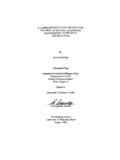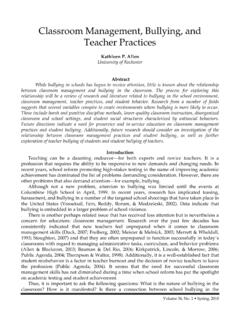Transcription of Inclusive Education and Effective Classroom Practices
1 Inclusive Education and Effective Classroom Practices European Agency for Development in Special Needs Education September 2001. Editor: Meijer This report has been produced and published by the European Agency for Development in Special Needs Education Extracts from the document are permitted provided a clear reference of the source is given. Editor: Cor Meijer, Project Manager for the European Agency for Development in Special Needs Education Technical editing & proof-reading: Martin Noble Editorial/AESOP. ISBN: 87-90591-15-1. September, 2001. European Agency for Development in Special Needs Education stre Stationsvej 33. DK- 5000 Odense C. Tel: +45 64 41 00 20. Fax: +45 64 41 23 03. E-mail: Web: 2. Contents INTRODUCTION 7. 1 GOALS OF THE Classroom AND SCHOOL PRACTICE PROJECT 8. Target group 8. Problems of teachers 8. How do teachers learn? 8. Output of the study 9. 2 FRAMEWORK 10. Classroom practice and teacher factors 10.
2 School factors 11. The main questions 11. 3 APPROACH AND METHODOLOGY 13. Methodology of the literature review 13. Framework and questions 14. How and where the information was obtained 14. The type of descriptors that were used (or how the right materials were found). 15. How the information was collected 15. How the information was processed and evaluated 16. How the information was synthesized 16. Timetable and planning of the project 17. 4 INTERNATIONAL LITERATURE REVIEW 18. Introduction 18. Questions 18. Methodology 18. Results of the search 19. Findings 19. Effects in terms of academic achievement 19. Effects in terms of social behaviour 29. Effects in terms of emotional development 30. Summary 31. Co-operative teaching 31. Peer tutoring or co-operative learning 31. Curriculum based measurement 32. Collaborative problem-solving 32. Mixed designs 32. 5 COUNTRY REVIEWS 33. Introduction 33. Austria 34. Preface 34. Framework 34.
3 Legal framework for work in the Classroom 35. Inclusive classes 35. 3. Supportive classes 35. Co-operative classes 35. Results of the pilot projects 35. Inclusive pedagogy 36. Teamwork 37. Integration of children with behaviour problems 38. Summary of findings 38. Brief analysis 39. Denmark 41. Introduction 41. Initiatives aiming to reduce the extent of special Education 41. Differentiation of Education 42. Special Education 42. Methodology 43. Which groups of students cause most problems? 43. Summary: what works? 43. Finland 45. Introduction 45. Review of the literature 45. France 48. Introduction and methodology 48. Integrating Classroom practice: evaluating cognitive/behavioural/social effects 49. Integrating Classroom Practices : evaluation of cognitive effects 49. Integrating Classroom Practices : evaluation of behavioural and social effects 49. The main problems 50. With what types or groups of pupils are these problems significant or do these problems remain significant?
4 51. Summary: what produces results?' 51. Germany 52. Introduction 52. Engagement of teachers, other personnel and teamwork 53. Co-operation with parents and other people 53. Equipment 53. Anchorage of special pedagogues 53. Flexible, differentiating instruction 54. Concentration and relaxation 54. Evaluation 54. Curriculum framework 54. Plans for support 54. Counsel 55. Training and further training 55. Greece 56. Iceland 58. Factors influencing educational inclusion 60. Ireland 62. Luxembourg 65. Introduction 65. Short description of literature 65. Classroom Practices and cognitive, emotional and social outcomes 65. What works? 66. The Netherlands 68. Introduction 68. 4. Methodology 68. Problems in regular Education and challenging special needs 69. Effective Classroom Practices in Inclusive settings 70. Interventions directed towards individual special needs pupils 70. Interventions at teacher level 71. The curriculum 72.
5 Discussion 73. Norway 75. Introduction 75. Methodology 75. Main problems concerning the inclusion of students with SEN in Norway 76. Summary: what works? 77. Portugal 79. Introduction 79. Literature review 79. Inclusion of pupils with SEN in Portugal 79. Sweden 84. Background 84. The view on special support in the National Curriculum 85. Result of literature review 85. Which factors within the context of the curriculum are essential for helping children with SEN in mainstream classrooms? 85. What is considered about the outcomes (social, cognitive and emotional) in Ahlberg's research? 86. Essential factors in Hemmingsson, Borell and Gustavsson 86. What is considered about the outcomes (social, cognitive, and emotional) in Hemmingsson et al.'s research? 87. Essential factors in Tinglev's study? 88. What is considered about the outcomes (social, cognitive, and emotional) in Tinglev's research? 88. The main problems relating to including pupils with SEN 88.
6 Which groups cause most problems? 89. Switzerland 91. Introduction 91. Methodology 91. Classroom Practices and cognitive outcomes 92. Class repetition 92. Supportive measures integrated classrooms 92. Composition of students in the Classroom and quality of teaching 93. Didactic measures 94. Attitudes and patterns of thinking 95. Classroom Practices and emotional outcomes 95. Classroom Practices and social outcomes 96. What are the main problems of Classroom Practices ? 96. Which groups of pupils with SEN cause the most problems within mainstream classes? 97. Summary: what works? 97. United Kingdom 100. Introduction: overview of studies on Classroom practice facilitating integration/. inclusion 100. Evidence related to general Effective Classroom management and strategies 102. School management facilitating Inclusive classrooms 102. 5. Movement from special to mainstream school 103. Differentiation 103. Specific teaching challenges: literacy 105.
7 Outcome studies 107. Introduction 107. Pupils with social/communication difficulties 107. Pupils with behavioural difficulties 108. Assertive discipline 108. Nurture groups 109. Circle time 110. Other studies 111. The main problems regarding inclusion 112. Type of special educational needs 112. The educational climate and demands on the teaching profession 113. Conceptual difficulties 113. 6 SYNTHESIS OF FINDINGS 115. Challenging types of special needs 115. Educational challenges within the context of inclusion 116. Effective Practices within the context of Inclusive Education 116. Co-operative teaching/co-teaching/team teaching 117. Co-operative learning/peer tutoring 117. Individual planning 117. Collaborative problem solving 117. Heterogeneous grouping/flexible instruction/differentiation 118. APPENDICES 119. Appendix A Documents: international literature review 119. Appendix B Documents: European literature review Austria 142.
8 Appendix C Documents: European literature review Denmark 150. Appendix D Documents: European literature review Finland 152. Appendix E Documents: European literature review France 157. Appendix F Documents: European literature review Germany 174. Appendix G Documents: European literature review Greece 185. Appendix H Documents: European literature review Ireland 187. Appendix I Documents: European literature review Luxembourg 191. Appendix J Documents: European literature review The Netherlands 193. Appendix K Documents: European literature review Norway 204. Appendix L Documents: European literature review Sweden 211. Appendix M Documents: European literature review Switzerland 215. Appendix N Documents: European literature review United Kingdom 230. References 243. Index of names 251. Index of subjects 254. 6. Inclusive Education and Effective Classroom Practices Introduction This report contains an overview of the findings of the first phase of the Classroom and School Practice project.
9 The project is focused on revealing, analysing, describing and disseminating Classroom Practices in Inclusive settings in such a way that European teachers can implement Inclusive Practices on a wider scale in their classrooms. The project is mainly focused on primary Education ; however, an extension to the secondary phase is planned for the near future. The complete study consists of three phases. In the first phase a literature review has been conducted in the participating countries in order to reveal the current state of the art of Effective Inclusive Practices . In addition, an international (mainly American) literature review was conducted in this phase. This part of the project addresses the question: which Practices have proven to be Effective in Inclusive Education ? In the second phase, an attempt will be made to select concrete examples of good Practices and to describe them in a systematic way. In the final phase, exchanges between different countries are organized in such a way that transfer of knowledge and Practices are maximized.
10 This report contains information obtained from the first phase of the project: the literature review. Though all member countries of the European Agency for Development in Special Needs Education are participants in the overall project, not all countries were able to submit detailed reports at this stage. (For a list of participating countries, the working partners and the representatives of the European Agency see Appendix A.) Literature reviews were received from 15 countries and they are presented in this report. Of course these reports show a considerable variation: some countries have an enormous amount of research in the field, while in others the research tradition is less rich. Since we are not comparing countries in terms of the state of the art of research on Effective Practices in Inclusive settings, this variation is of no importance. Our focus is to reveal the current body of knowledge on the issue independent of the specific country.





